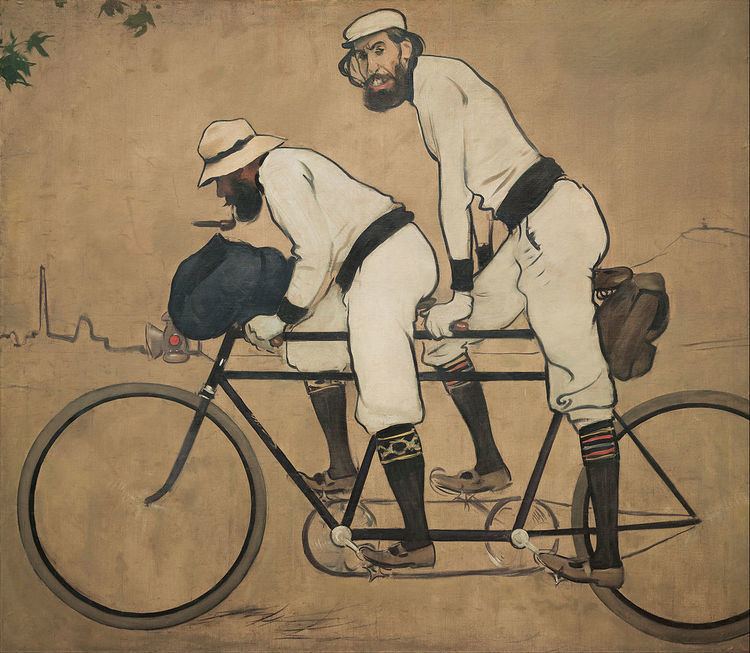Year 1897 (1897) | Created 1897 | |
 | ||
Similar Ramon Casas artwork, Other artwork | ||
Ramon casas and pere romeu on a tandem
Ramon Casas and Pere Romeu on a Tandem is a painting by Ramon Casas in exhibition at the National Art Museum of Catalonia in Barcelona.
Contents
Description
Casas painted Ramon Casas and Pere Romeu on a Tandem in 1897 specifically for the interior of Els Quatre Gats, a bar that was at the center of the Modernisme art movement in Barcelona. It depicts Casas and Pere Romeu, one of the promoters of Els Quatre Gats, on a tandem bicycle against the Barcelona skyline. Casas is seen in profile with his pipe, while Romeu looks directly at the viewer. Although painted on canvas, the composition has the graphic quality of a huge poster with its bold drawing and simplified forms, reflecting the fact that the artist was a skilled poster designer and illustrator.
The original inscription on the right side of the painting, which was later cut off, read "to ride a bicycle, you can't go with your back straight." The message described the attitude of the bar founders (two of whom are depicted here), that in order to make progress, you must break with tradition, as was done at Els Quatre Gats. In 1901, this painting was replaced with another large composition by Casas, entitled Ramon Casas and Pere Romeu in an Automobile, in which the tandem bicycle has given way to a car, symbolizing the new century. When reproductions of the two paintings appeared in the magazine Pel & Ploma, they were referred to as The End of the 19th Century and The Beginning of the 20th Century, respectively.
Ramon Casas
Ramon Casas (Catalan pronunciation: [rəˈmoŋ ˈkazəs]) was a Catalan artist. Living through a turbulent time in the history of his native Barcelona, he was known as a portraitist, sketching and painting the intellectual, economic, and political elite of Barcelona, Paris, and beyond; he was also known for his paintings of crowd scenes ranging from the audience at a bullfight to the assembly for an execution to rioters in the Barcelona streets. His posters and postcards helped define the Modernisme art movement.
Els Quatre Gats
The emerging Modernisme art movement gained a center with the opening of Els Quatre Gats, a bar modeled on the Parisian café Le Chat Noir, whose founder, Rodolphe Salis, had recently died. “Four Cats” is a colloquial Catalan expression for “only a few people” and the name of Els Quatre Gats is dervived from this saying. Casas largely financed the bar on the ground floor of Casa Martí, a building by Architect Josep Puig i Cadafalch on Montsió Street near the center of Barcelona; it opened on June 12, 1897 and closed in 1903 (and was later reconstructed in 1978). His partners in the enterprise were Pere Romeu, as well as Santiago Rusiñol and Miquel Utrillo. The bar organized tertulias and revolving art exhibits, including the first -man shows by Pablo Picasso; Ramon Casas and Pere Romeu on a Tandem was the most prominent piece in its permanent collection.
Modernisme
Modernisme (Catalan pronunciation: [muðərˈnizmə], Catalan for "art nouveau") was a cultural movement associated with the search for Catalan national identity. It is often understood as an equivalent to a number of fin-de-siècle art movements, such as Art Nouveau, Jugendstil, Secessionism, and Liberty style, and was active from roughly 1888 (the First International Exhibition of Barcelona) to 1911 (the death of Joan Maragall, the most important Modernista poet). The Modernisme movement was centered on the city of Barcelona, and is best known for its architectural expression, especially the work of Antoni Gaudí, but was also significant in sculpture, poetry, theater, and painting.
